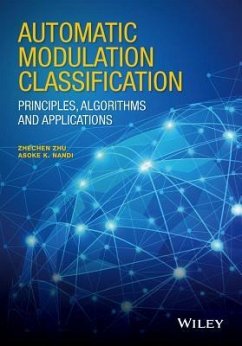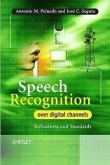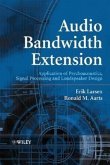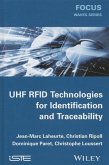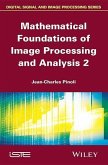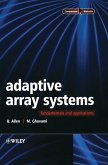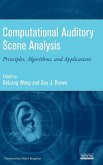Zhechen Zhu, Asoke K Nandi
Automatic Modulation Classification
Principles, Algorithms and Applications
Zhechen Zhu, Asoke K Nandi
Automatic Modulation Classification
Principles, Algorithms and Applications
- Gebundenes Buch
- Merkliste
- Auf die Merkliste
- Bewerten Bewerten
- Teilen
- Produkt teilen
- Produkterinnerung
- Produkterinnerung
Automatic Modulation Classification (AMC) has been a key technology in many military, security, and civilian telecommunication applications for decades. In military and security applications, modulation often serves as another level of encryption; in modern civilian applications, multiple modulation types can be employed by a signal transmitter to control the data rate and link reliability. This book offers comprehensive documentation of AMC models, algorithms and implementations for successful modulation recognition. It provides an invaluable theoretical and numerical comparison of AMC…mehr
Andere Kunden interessierten sich auch für
![Speech Recognition Over Digital Channels Speech Recognition Over Digital Channels]() Antonio PeinadoSpeech Recognition Over Digital Channels156,99 €
Antonio PeinadoSpeech Recognition Over Digital Channels156,99 €![Acoustic Particle Velocity Measurements Using Lasers Acoustic Particle Velocity Measurements Using Lasers]() Jean-Christophe ValièreAcoustic Particle Velocity Measurements Using Lasers186,99 €
Jean-Christophe ValièreAcoustic Particle Velocity Measurements Using Lasers186,99 €![Audio Bandwidth Extension Audio Bandwidth Extension]() Erik LarsenAudio Bandwidth Extension146,99 €
Erik LarsenAudio Bandwidth Extension146,99 €![UHF RFID Technologies for Identification and Traceability UHF RFID Technologies for Identification and Traceability]() Jean-Marc LaheurteUHF RFID Technologies for Identification and Traceability186,99 €
Jean-Marc LaheurteUHF RFID Technologies for Identification and Traceability186,99 €![Mathematical Foundations of Image Processing and Analysis, Volume 2 Mathematical Foundations of Image Processing and Analysis, Volume 2]() Jean-Charles PinoliMathematical Foundations of Image Processing and Analysis, Volume 2235,99 €
Jean-Charles PinoliMathematical Foundations of Image Processing and Analysis, Volume 2235,99 €![Adaptive Array Systems Adaptive Array Systems]() Ben AllenAdaptive Array Systems112,99 €
Ben AllenAdaptive Array Systems112,99 €![Computational Auditory Analysis Computational Auditory Analysis]() Computational Auditory Analysis156,99 €
Computational Auditory Analysis156,99 €-
-
-
Automatic Modulation Classification (AMC) has been a key technology in many military, security, and civilian telecommunication applications for decades. In military and security applications, modulation often serves as another level of encryption; in modern civilian applications, multiple modulation types can be employed by a signal transmitter to control the data rate and link reliability. This book offers comprehensive documentation of AMC models, algorithms and implementations for successful modulation recognition. It provides an invaluable theoretical and numerical comparison of AMC algorithms, as well as guidance on state-of-the-art classification designs with specific military and civilian applications in mind. Key Features: * Provides an important collection of AMC algorithms in five major categories, from likelihood-based classifiers and distribution-test-based classifiers to feature-based classifiers, machine learning assisted classifiers and blind modulation classifiers * Lists detailed implementation for each algorithm based on a unified theoretical background and a comprehensive theoretical and numerical performance comparison * Gives clear guidance for the design of specific automatic modulation classifiers for different practical applications in both civilian and military communication systems * Includes a MATLAB toolbox on a companion website offering the implementation of a selection of methods discussed in the book
Hinweis: Dieser Artikel kann nur an eine deutsche Lieferadresse ausgeliefert werden.
Hinweis: Dieser Artikel kann nur an eine deutsche Lieferadresse ausgeliefert werden.
Produktdetails
- Produktdetails
- Verlag: Wiley
- Seitenzahl: 192
- Erscheinungstermin: 16. Februar 2015
- Englisch
- Abmessung: 241mm x 168mm x 15mm
- Gewicht: 458g
- ISBN-13: 9781118906491
- ISBN-10: 1118906497
- Artikelnr.: 41961932
- Herstellerkennzeichnung
- Libri GmbH
- Europaallee 1
- 36244 Bad Hersfeld
- gpsr@libri.de
- Verlag: Wiley
- Seitenzahl: 192
- Erscheinungstermin: 16. Februar 2015
- Englisch
- Abmessung: 241mm x 168mm x 15mm
- Gewicht: 458g
- ISBN-13: 9781118906491
- ISBN-10: 1118906497
- Artikelnr.: 41961932
- Herstellerkennzeichnung
- Libri GmbH
- Europaallee 1
- 36244 Bad Hersfeld
- gpsr@libri.de
Zhechen Zhu, Department of Electronic & Computer Engineering, Brunel University London, UK Zhechen Zhu received his B.Eng. degree in the Department of Electrical Engineering and Electronics from the University of Liverpool in 2010. His undergraduate project was awarded the Farnell Company Prize. He is currently pursuing his PhD degree at Brunel University conducting research on the subject of automatic modulation classification. His research interests include high order statistics, machine learning, statistical signal processing, blind signal processing, and their application in signal estimation and classification. Asoke K. Nandi, Department of Electronic & Computer Engineering, Brunel University London, UK Prof. Nandi is Chair and Head of the Electronic and Computer Engineering Department at Brunel University London, UK. He leads the Signal Processing and Communications Research Group with interests in the areas of signal processing, machine learning, and communications research. He is a Finland Distinguished Professor at the University of Jyvaskyla, Finland. In 1983 Professor Nandi was a member of the UA1 team at CERN that discovered the three fundamental particles known as W+, W¿ and Z0, providing the evidence for the unification of the electromagnetic and weak forces, which was recognized by the Nobel Committee for Physics in 1984. He has authored or co-authored more than 190 journal papers, and 2 books. The Google Scholar h-index of his publications is 54. In 2010 he received the Glory of Bengal Award for his outstanding achievements in scientific research, and in 2012 was awarded the IEEE Heinrich Hertz Award. Prof. Nandi is a Fellow of the IEEE.
About the Authors xi
Preface xiii
List of Abbreviations xv
List of Symbols xix
1 Introduction 1
1.1 Background 1
1.2 Applications of AMC 2
1.2.1 Military Applications 2
1.2.2 Civilian Applications 3
1.3 Field Overview and Book Scope 5
1.4 Modulation and Communication System Basics 6
1.4.1 Analogue Systems and Modulations 6
1.4.2 Digital Systems and Modulations 8
1.4.3 Received Signal with Channel Effects 15
1.5 Conclusion 16
References 16
2 Signal Models for Modulation Classification 19
2.1 Introduction 19
2.2 Signal Model in AWGN Channel 20
2.2.1 Signal Distribution of I-Q Segments 21
2.2.2 Signal Distribution of Signal Phase 23
2.2.3 Signal Distribution of Signal Magnitude 25
2.3 Signal Models in Fading Channel 25
2.4 Signal Models in Non-Gaussian Channel 28
2.4.1 Middleton's Class A Model 28
2.4.2 Symmetric Alpha Stable Model 30
2.4.3 Gaussian Mixture Model 30
2.5 Conclusion 31
References 32
3 Likelihood-based Classifiers 35
3.1 Introduction 35
3.2 Maximum Likelihood Classifiers 36
3.2.1 Likelihood Function in AWGN Channels 36
3.2.2 Likelihood Function in Fading Channels 38
3.2.3 Likelihood Function in Non-Gaussian Noise Channels 39
3.2.4 Maximum Likelihood Classification Decision Making 39
3.3 Likelihood Ratio Test for Unknown Channel Parameters 40
3.3.1 Average Likelihood Ratio Test 40
3.3.2 Generalized Likelihood Ratio Test 41
3.3.3 Hybrid Likelihood Ratio Test 43
3.4 Complexity Reduction 44
3.4.1 Discrete Likelihood Ratio Test and Lookup Table 44
3.4.2 Minimum Distance Likelihood Function 45
3.4.3 Non-Parametric Likelihood Function 45
3.5 Conclusion 45
References 46
4 Distribution Test-based Classifier 49
4.1 Introduction 49
4.2 Kolmogorov-Smirnov Test Classifier 50
4.2.1 The KS Test for Goodness of Fit 51
4.2.2 One-sample KS Test Classifier 53
4.2.3 Two-sample KS Test Classifier 55
4.2.4 Phase Difference Classifier 56
4.3 Cramer-Von Mises Test Classifier 57
4.4 Anderson-Darling Test Classifier 57
4.5 Optimized Distribution Sampling Test Classifier 58
4.5.1 Sampling Location Optimization 59
4.5.2 Distribution Sampling 60
4.5.3 Classification Decision Metrics 61
4.5.4 Modulation Classification Decision Making 62
4.6 Conclusion 63
References 63
5 Modulation Classification Features 65
5.1 Introduction 65
5.2 Signal Spectral-based Features 66
5.2.1 Signal Spectral-based Features 66
5.2.2 Spectral-based Features Specialities 69
5.2.3 Spectral-based Features Decision Making 70
5.2.4 Decision Threshold Optimization 70
5.3 Wavelet Transform-based Features 71
5.4 High-order Statistics-based Features 74
5.4.1 High-order Moment-based Features 74
5.4.2 High-order Cumulant-based Features 75
5.5 Cyclostationary Analysis-based Features 76
5.6 Conclusion 79
References 79
6 Machine Learning for Modulation Classification 81
6.1 Introduction 81
6.2 K-Nearest Neighbour Classifier 81
6.2.1 Reference Feature Space 82
6.2.2 Distance Definition 82
6.2.3 K-Nearest Neighbour Decision 83
6.3 Support Vector Machine Classifier 84
6.4 Logistic Regression for Feature Combination 86
6.5 Artificial Neural Network for Feature Combination 87
6.6 Genetic Algorithm for Feature Selection 89
6.7 Genetic Programming for Feature Selection and Combination 90
6.7.1 Tree-structured Solution 91
6.7.2 Genetic Operators 91
6.7.3 Fitness Evaluation 93
6.8 Conclusion 94
References 94
7 Blind Modulation Classification 97
7.1 Introduction 97
7.2 Expectation Maximization with Likelihood-based Classifier 98
7.2.1 Expectation Maximization Estimator 98
7.2.2 Maximum Likelihood Classifier 101
7.2.3 Minimum Likelihood Distance Classifier 102
7.3 Minimum Distance Centroid Estimation and Non-parametric Likelihood
Classifier 103
7.3.1 Minimum Distance Centroid Estimation 103
7.3.2 Non-parametric Likelihood Function 105
7.4 Conclusion 107
References 107
8 Comparison of Modulation Classifiers 109
8.1 Introduction 109
8.2 System Requirements and Applicable Modulations 110
8.3 Classification Accuracy with Additive Noise 110
8.3.1 Benchmarking Classifiers 113
8.3.2 Performance Comparison in AWGN Channel 114
8.4 Classification Accuracy with Limited Signal Length 120
8.5 Classification Robustness against Phase Offset 126
8.6 Classification Robustness against Frequency Offset 132
8.7 Computational Complexity 137
8.8 Conclusion 138
References 139
9 Modulation Classification for Civilian Applications 141
9.1 Introduction 141
9.2 Modulation Classification for High-order Modulations 141
9.3 Modulation Classification for Link-adaptation Systems 143
9.4 Modulation Classification for MIMO Systems 144
9.5 Conclusion 150
References 150
10 Modulation Classifier Design for Military Applications 153
10.1 Introduction 153
10.2 Modulation Classifier with Unknown Modulation Pool 154
10.3 Modulation Classifier against Low Probability of Detection 157
10.3.1 Classification of DSSS Signals 157
10.3.2 Classification of FHSS Signals 158
10.4 Conclusion 160
References 160
Index 161
Preface xiii
List of Abbreviations xv
List of Symbols xix
1 Introduction 1
1.1 Background 1
1.2 Applications of AMC 2
1.2.1 Military Applications 2
1.2.2 Civilian Applications 3
1.3 Field Overview and Book Scope 5
1.4 Modulation and Communication System Basics 6
1.4.1 Analogue Systems and Modulations 6
1.4.2 Digital Systems and Modulations 8
1.4.3 Received Signal with Channel Effects 15
1.5 Conclusion 16
References 16
2 Signal Models for Modulation Classification 19
2.1 Introduction 19
2.2 Signal Model in AWGN Channel 20
2.2.1 Signal Distribution of I-Q Segments 21
2.2.2 Signal Distribution of Signal Phase 23
2.2.3 Signal Distribution of Signal Magnitude 25
2.3 Signal Models in Fading Channel 25
2.4 Signal Models in Non-Gaussian Channel 28
2.4.1 Middleton's Class A Model 28
2.4.2 Symmetric Alpha Stable Model 30
2.4.3 Gaussian Mixture Model 30
2.5 Conclusion 31
References 32
3 Likelihood-based Classifiers 35
3.1 Introduction 35
3.2 Maximum Likelihood Classifiers 36
3.2.1 Likelihood Function in AWGN Channels 36
3.2.2 Likelihood Function in Fading Channels 38
3.2.3 Likelihood Function in Non-Gaussian Noise Channels 39
3.2.4 Maximum Likelihood Classification Decision Making 39
3.3 Likelihood Ratio Test for Unknown Channel Parameters 40
3.3.1 Average Likelihood Ratio Test 40
3.3.2 Generalized Likelihood Ratio Test 41
3.3.3 Hybrid Likelihood Ratio Test 43
3.4 Complexity Reduction 44
3.4.1 Discrete Likelihood Ratio Test and Lookup Table 44
3.4.2 Minimum Distance Likelihood Function 45
3.4.3 Non-Parametric Likelihood Function 45
3.5 Conclusion 45
References 46
4 Distribution Test-based Classifier 49
4.1 Introduction 49
4.2 Kolmogorov-Smirnov Test Classifier 50
4.2.1 The KS Test for Goodness of Fit 51
4.2.2 One-sample KS Test Classifier 53
4.2.3 Two-sample KS Test Classifier 55
4.2.4 Phase Difference Classifier 56
4.3 Cramer-Von Mises Test Classifier 57
4.4 Anderson-Darling Test Classifier 57
4.5 Optimized Distribution Sampling Test Classifier 58
4.5.1 Sampling Location Optimization 59
4.5.2 Distribution Sampling 60
4.5.3 Classification Decision Metrics 61
4.5.4 Modulation Classification Decision Making 62
4.6 Conclusion 63
References 63
5 Modulation Classification Features 65
5.1 Introduction 65
5.2 Signal Spectral-based Features 66
5.2.1 Signal Spectral-based Features 66
5.2.2 Spectral-based Features Specialities 69
5.2.3 Spectral-based Features Decision Making 70
5.2.4 Decision Threshold Optimization 70
5.3 Wavelet Transform-based Features 71
5.4 High-order Statistics-based Features 74
5.4.1 High-order Moment-based Features 74
5.4.2 High-order Cumulant-based Features 75
5.5 Cyclostationary Analysis-based Features 76
5.6 Conclusion 79
References 79
6 Machine Learning for Modulation Classification 81
6.1 Introduction 81
6.2 K-Nearest Neighbour Classifier 81
6.2.1 Reference Feature Space 82
6.2.2 Distance Definition 82
6.2.3 K-Nearest Neighbour Decision 83
6.3 Support Vector Machine Classifier 84
6.4 Logistic Regression for Feature Combination 86
6.5 Artificial Neural Network for Feature Combination 87
6.6 Genetic Algorithm for Feature Selection 89
6.7 Genetic Programming for Feature Selection and Combination 90
6.7.1 Tree-structured Solution 91
6.7.2 Genetic Operators 91
6.7.3 Fitness Evaluation 93
6.8 Conclusion 94
References 94
7 Blind Modulation Classification 97
7.1 Introduction 97
7.2 Expectation Maximization with Likelihood-based Classifier 98
7.2.1 Expectation Maximization Estimator 98
7.2.2 Maximum Likelihood Classifier 101
7.2.3 Minimum Likelihood Distance Classifier 102
7.3 Minimum Distance Centroid Estimation and Non-parametric Likelihood
Classifier 103
7.3.1 Minimum Distance Centroid Estimation 103
7.3.2 Non-parametric Likelihood Function 105
7.4 Conclusion 107
References 107
8 Comparison of Modulation Classifiers 109
8.1 Introduction 109
8.2 System Requirements and Applicable Modulations 110
8.3 Classification Accuracy with Additive Noise 110
8.3.1 Benchmarking Classifiers 113
8.3.2 Performance Comparison in AWGN Channel 114
8.4 Classification Accuracy with Limited Signal Length 120
8.5 Classification Robustness against Phase Offset 126
8.6 Classification Robustness against Frequency Offset 132
8.7 Computational Complexity 137
8.8 Conclusion 138
References 139
9 Modulation Classification for Civilian Applications 141
9.1 Introduction 141
9.2 Modulation Classification for High-order Modulations 141
9.3 Modulation Classification for Link-adaptation Systems 143
9.4 Modulation Classification for MIMO Systems 144
9.5 Conclusion 150
References 150
10 Modulation Classifier Design for Military Applications 153
10.1 Introduction 153
10.2 Modulation Classifier with Unknown Modulation Pool 154
10.3 Modulation Classifier against Low Probability of Detection 157
10.3.1 Classification of DSSS Signals 157
10.3.2 Classification of FHSS Signals 158
10.4 Conclusion 160
References 160
Index 161
About the Authors xi
Preface xiii
List of Abbreviations xv
List of Symbols xix
1 Introduction 1
1.1 Background 1
1.2 Applications of AMC 2
1.2.1 Military Applications 2
1.2.2 Civilian Applications 3
1.3 Field Overview and Book Scope 5
1.4 Modulation and Communication System Basics 6
1.4.1 Analogue Systems and Modulations 6
1.4.2 Digital Systems and Modulations 8
1.4.3 Received Signal with Channel Effects 15
1.5 Conclusion 16
References 16
2 Signal Models for Modulation Classification 19
2.1 Introduction 19
2.2 Signal Model in AWGN Channel 20
2.2.1 Signal Distribution of I-Q Segments 21
2.2.2 Signal Distribution of Signal Phase 23
2.2.3 Signal Distribution of Signal Magnitude 25
2.3 Signal Models in Fading Channel 25
2.4 Signal Models in Non-Gaussian Channel 28
2.4.1 Middleton's Class A Model 28
2.4.2 Symmetric Alpha Stable Model 30
2.4.3 Gaussian Mixture Model 30
2.5 Conclusion 31
References 32
3 Likelihood-based Classifiers 35
3.1 Introduction 35
3.2 Maximum Likelihood Classifiers 36
3.2.1 Likelihood Function in AWGN Channels 36
3.2.2 Likelihood Function in Fading Channels 38
3.2.3 Likelihood Function in Non-Gaussian Noise Channels 39
3.2.4 Maximum Likelihood Classification Decision Making 39
3.3 Likelihood Ratio Test for Unknown Channel Parameters 40
3.3.1 Average Likelihood Ratio Test 40
3.3.2 Generalized Likelihood Ratio Test 41
3.3.3 Hybrid Likelihood Ratio Test 43
3.4 Complexity Reduction 44
3.4.1 Discrete Likelihood Ratio Test and Lookup Table 44
3.4.2 Minimum Distance Likelihood Function 45
3.4.3 Non-Parametric Likelihood Function 45
3.5 Conclusion 45
References 46
4 Distribution Test-based Classifier 49
4.1 Introduction 49
4.2 Kolmogorov-Smirnov Test Classifier 50
4.2.1 The KS Test for Goodness of Fit 51
4.2.2 One-sample KS Test Classifier 53
4.2.3 Two-sample KS Test Classifier 55
4.2.4 Phase Difference Classifier 56
4.3 Cramer-Von Mises Test Classifier 57
4.4 Anderson-Darling Test Classifier 57
4.5 Optimized Distribution Sampling Test Classifier 58
4.5.1 Sampling Location Optimization 59
4.5.2 Distribution Sampling 60
4.5.3 Classification Decision Metrics 61
4.5.4 Modulation Classification Decision Making 62
4.6 Conclusion 63
References 63
5 Modulation Classification Features 65
5.1 Introduction 65
5.2 Signal Spectral-based Features 66
5.2.1 Signal Spectral-based Features 66
5.2.2 Spectral-based Features Specialities 69
5.2.3 Spectral-based Features Decision Making 70
5.2.4 Decision Threshold Optimization 70
5.3 Wavelet Transform-based Features 71
5.4 High-order Statistics-based Features 74
5.4.1 High-order Moment-based Features 74
5.4.2 High-order Cumulant-based Features 75
5.5 Cyclostationary Analysis-based Features 76
5.6 Conclusion 79
References 79
6 Machine Learning for Modulation Classification 81
6.1 Introduction 81
6.2 K-Nearest Neighbour Classifier 81
6.2.1 Reference Feature Space 82
6.2.2 Distance Definition 82
6.2.3 K-Nearest Neighbour Decision 83
6.3 Support Vector Machine Classifier 84
6.4 Logistic Regression for Feature Combination 86
6.5 Artificial Neural Network for Feature Combination 87
6.6 Genetic Algorithm for Feature Selection 89
6.7 Genetic Programming for Feature Selection and Combination 90
6.7.1 Tree-structured Solution 91
6.7.2 Genetic Operators 91
6.7.3 Fitness Evaluation 93
6.8 Conclusion 94
References 94
7 Blind Modulation Classification 97
7.1 Introduction 97
7.2 Expectation Maximization with Likelihood-based Classifier 98
7.2.1 Expectation Maximization Estimator 98
7.2.2 Maximum Likelihood Classifier 101
7.2.3 Minimum Likelihood Distance Classifier 102
7.3 Minimum Distance Centroid Estimation and Non-parametric Likelihood
Classifier 103
7.3.1 Minimum Distance Centroid Estimation 103
7.3.2 Non-parametric Likelihood Function 105
7.4 Conclusion 107
References 107
8 Comparison of Modulation Classifiers 109
8.1 Introduction 109
8.2 System Requirements and Applicable Modulations 110
8.3 Classification Accuracy with Additive Noise 110
8.3.1 Benchmarking Classifiers 113
8.3.2 Performance Comparison in AWGN Channel 114
8.4 Classification Accuracy with Limited Signal Length 120
8.5 Classification Robustness against Phase Offset 126
8.6 Classification Robustness against Frequency Offset 132
8.7 Computational Complexity 137
8.8 Conclusion 138
References 139
9 Modulation Classification for Civilian Applications 141
9.1 Introduction 141
9.2 Modulation Classification for High-order Modulations 141
9.3 Modulation Classification for Link-adaptation Systems 143
9.4 Modulation Classification for MIMO Systems 144
9.5 Conclusion 150
References 150
10 Modulation Classifier Design for Military Applications 153
10.1 Introduction 153
10.2 Modulation Classifier with Unknown Modulation Pool 154
10.3 Modulation Classifier against Low Probability of Detection 157
10.3.1 Classification of DSSS Signals 157
10.3.2 Classification of FHSS Signals 158
10.4 Conclusion 160
References 160
Index 161
Preface xiii
List of Abbreviations xv
List of Symbols xix
1 Introduction 1
1.1 Background 1
1.2 Applications of AMC 2
1.2.1 Military Applications 2
1.2.2 Civilian Applications 3
1.3 Field Overview and Book Scope 5
1.4 Modulation and Communication System Basics 6
1.4.1 Analogue Systems and Modulations 6
1.4.2 Digital Systems and Modulations 8
1.4.3 Received Signal with Channel Effects 15
1.5 Conclusion 16
References 16
2 Signal Models for Modulation Classification 19
2.1 Introduction 19
2.2 Signal Model in AWGN Channel 20
2.2.1 Signal Distribution of I-Q Segments 21
2.2.2 Signal Distribution of Signal Phase 23
2.2.3 Signal Distribution of Signal Magnitude 25
2.3 Signal Models in Fading Channel 25
2.4 Signal Models in Non-Gaussian Channel 28
2.4.1 Middleton's Class A Model 28
2.4.2 Symmetric Alpha Stable Model 30
2.4.3 Gaussian Mixture Model 30
2.5 Conclusion 31
References 32
3 Likelihood-based Classifiers 35
3.1 Introduction 35
3.2 Maximum Likelihood Classifiers 36
3.2.1 Likelihood Function in AWGN Channels 36
3.2.2 Likelihood Function in Fading Channels 38
3.2.3 Likelihood Function in Non-Gaussian Noise Channels 39
3.2.4 Maximum Likelihood Classification Decision Making 39
3.3 Likelihood Ratio Test for Unknown Channel Parameters 40
3.3.1 Average Likelihood Ratio Test 40
3.3.2 Generalized Likelihood Ratio Test 41
3.3.3 Hybrid Likelihood Ratio Test 43
3.4 Complexity Reduction 44
3.4.1 Discrete Likelihood Ratio Test and Lookup Table 44
3.4.2 Minimum Distance Likelihood Function 45
3.4.3 Non-Parametric Likelihood Function 45
3.5 Conclusion 45
References 46
4 Distribution Test-based Classifier 49
4.1 Introduction 49
4.2 Kolmogorov-Smirnov Test Classifier 50
4.2.1 The KS Test for Goodness of Fit 51
4.2.2 One-sample KS Test Classifier 53
4.2.3 Two-sample KS Test Classifier 55
4.2.4 Phase Difference Classifier 56
4.3 Cramer-Von Mises Test Classifier 57
4.4 Anderson-Darling Test Classifier 57
4.5 Optimized Distribution Sampling Test Classifier 58
4.5.1 Sampling Location Optimization 59
4.5.2 Distribution Sampling 60
4.5.3 Classification Decision Metrics 61
4.5.4 Modulation Classification Decision Making 62
4.6 Conclusion 63
References 63
5 Modulation Classification Features 65
5.1 Introduction 65
5.2 Signal Spectral-based Features 66
5.2.1 Signal Spectral-based Features 66
5.2.2 Spectral-based Features Specialities 69
5.2.3 Spectral-based Features Decision Making 70
5.2.4 Decision Threshold Optimization 70
5.3 Wavelet Transform-based Features 71
5.4 High-order Statistics-based Features 74
5.4.1 High-order Moment-based Features 74
5.4.2 High-order Cumulant-based Features 75
5.5 Cyclostationary Analysis-based Features 76
5.6 Conclusion 79
References 79
6 Machine Learning for Modulation Classification 81
6.1 Introduction 81
6.2 K-Nearest Neighbour Classifier 81
6.2.1 Reference Feature Space 82
6.2.2 Distance Definition 82
6.2.3 K-Nearest Neighbour Decision 83
6.3 Support Vector Machine Classifier 84
6.4 Logistic Regression for Feature Combination 86
6.5 Artificial Neural Network for Feature Combination 87
6.6 Genetic Algorithm for Feature Selection 89
6.7 Genetic Programming for Feature Selection and Combination 90
6.7.1 Tree-structured Solution 91
6.7.2 Genetic Operators 91
6.7.3 Fitness Evaluation 93
6.8 Conclusion 94
References 94
7 Blind Modulation Classification 97
7.1 Introduction 97
7.2 Expectation Maximization with Likelihood-based Classifier 98
7.2.1 Expectation Maximization Estimator 98
7.2.2 Maximum Likelihood Classifier 101
7.2.3 Minimum Likelihood Distance Classifier 102
7.3 Minimum Distance Centroid Estimation and Non-parametric Likelihood
Classifier 103
7.3.1 Minimum Distance Centroid Estimation 103
7.3.2 Non-parametric Likelihood Function 105
7.4 Conclusion 107
References 107
8 Comparison of Modulation Classifiers 109
8.1 Introduction 109
8.2 System Requirements and Applicable Modulations 110
8.3 Classification Accuracy with Additive Noise 110
8.3.1 Benchmarking Classifiers 113
8.3.2 Performance Comparison in AWGN Channel 114
8.4 Classification Accuracy with Limited Signal Length 120
8.5 Classification Robustness against Phase Offset 126
8.6 Classification Robustness against Frequency Offset 132
8.7 Computational Complexity 137
8.8 Conclusion 138
References 139
9 Modulation Classification for Civilian Applications 141
9.1 Introduction 141
9.2 Modulation Classification for High-order Modulations 141
9.3 Modulation Classification for Link-adaptation Systems 143
9.4 Modulation Classification for MIMO Systems 144
9.5 Conclusion 150
References 150
10 Modulation Classifier Design for Military Applications 153
10.1 Introduction 153
10.2 Modulation Classifier with Unknown Modulation Pool 154
10.3 Modulation Classifier against Low Probability of Detection 157
10.3.1 Classification of DSSS Signals 157
10.3.2 Classification of FHSS Signals 158
10.4 Conclusion 160
References 160
Index 161

